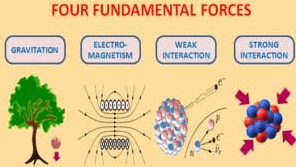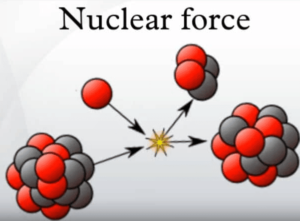What are the four fundamental forces in nature?
In physics, the fundamental forces, also known as fundamental interactions, are the forces that do not appear to be reducible to more basic forces. There are four fundamental forces the gravitational force and electromagnetic force, which are said to be long-range forces whose effects can be seen directly in daily life, and the strong force and weak force, which produce forces at minuscule, subatomic distances and govern nuclear forces. Some scientists say that a fifth force might exist.
Man has always desired to comprehend the complexity of nature in terms of as few elementary concepts as possible. Among its quest, in Feynman’s words, has been the one for “wheel within wheels”, the task of Natural Philosophy being to discover the innermost wheels if any such exists. A second quest has concentrated on the fundamental forces, which make the wheels go round and enmesh with one another.
Although we have been familiar with the basic forces and some of the basic building blocks of the matter, here we are going to study the modern concepts about both of these.
List of 4 fundamental forces of nature

A list of 4 Basic forces is given below:
- Gravitational force
- Electromagnetic force
- The strong nuclear force
- The Weak Nuclear force
The electric and magnetic forces were unified to get an electromagnetic force by Faraday and Maxwell, who was able to prove that a current is induced in a coil whenever the magnetic flux passing through the coil is changed; leaving behind four fundamental forces, the strong nuclear force, the electromagnetic force, the weak nuclear force, and the gravitational force.
These four fundamental forces of nature have seemed for some time quite different from one another. Despite its different effective strengths, the strong nuclear force is effective only within sub-nuclear distances and therefore, confines the neutrons and neutrons within the nucleus.
The electromagnetic force is long-range and causes all chemical reactions. It binds together atoms, molecules, crystals, trees, buildings, and you. This force acting on a microscopic level is responsible for a variety of apparently different microscopic forces such as friction, cohesion, and adhesion.
The weak nuclear force is short-range, like the strong nuclear force, and is responsible for the spontaneous breaking up of the radioactive elements. It is a sort of repulsive force of a very short range (10 -17 m). It is usually masked by the effect of the strong and electromagnetic force inside the nuclei.
The gravitational force, like the electromagnetic force, is again long-range, extending up to and beyond the remotest stars and galaxies. It keeps you, the atmosphere, and the seas fixed to the surface of the planet. It gives rise to ocean tides and keeps the planets moving in their orbits around the Sun. Gravitational forces are weak forces found in nature.
These widely disparate properties of the four basic forces have not stopped scientists from finding a common cause for them all.
One hundred years after the unification of electric and magnetic forces into electromagnetic force, in 1979, the physics noble prize was conferred on Glashow, Weinberg, and Abdus Salam for the unification of electromagnetic and weak forces.
It is further expected that a strong nuclear force will eventually unite with an electroweak force to make up a single entity resulting in the grand unified electro-nuclear force.
What are nuclear forces?
Normally systems are held together by the forces:
- Gravitational force
- The electrostatic or electromagnetic force

Since the nucleus has only protons and neutrons and as the neutron has no charge so this force is zero between two neutrons or between a proton and a neutron. Coulomb repulsion between two protons tends to tear the nucleus apart. Although the gravitational force is an attractive one it is similar by a factor ≈10 ³9 then electrical repulsion between two protons, so it can be ignored. There is a third force called nuclear force. This force is further divided into two types.
- Nuclear strong force
- Nuclear weak force
The nuclear strong force is very strong and effective at a distance of nuclear size ( ≈10-¹3 cm ≈10-15 m) and negligible at a distance 10-10 m and that is why this force is also called short-range force. Information about the nature of nuclear forces has been sought in two ways.
- Interaction between two nucleons, both in a bound state and in the scattering of neutrons and protons by protons.
- The study of the proportion of the complex nuclei and the attempt to deduce, from these properties the nature of the interaction between the nucleons.
Characteristics of nuclear forces:
There are basic characteristics of the nuclear forces which are as follows:
- The nuclear forces are by far the strongest class of forces known.
- Nuclear forces are unique short-range forces.
- In regard to their net effect on the average, the nuclear forces must be attractive forces, otherwise, nuclei would not exist.
- Nuclear forces between two neutrons in particular quantum states must be nearly the repulsion of the proton is not of course account.
- Nuclear forces can not be such that there is nearly the same purely attractive interaction potential between all pairs of nucleons in all quantum states. This is direct approximately proportional to A for all nuclei with A ≥ 4
The nature of nuclear forces is still unknown. There is a certain interpretation but they are not very satisfactory. A theory given by Yukawa is quite satisfying but not very perfect.
Nature of nuclear forces:
Explain the meson theory of nuclear forces.
Yukawa’s 1935 proposed a theory of nuclear forces which is called the meson theory.
- According to this theory, a meson field exists between every two particles which attract each other.
- The cause of these attractive forces is the exchange of a meson between every pair of particles. This means it may be neutral, positive, or negative. To consider a rough idea of the attractive force between two nucleons consider persons walking side by side and who are exchanging a ball continuously between themselves. They cannot separate beyond a certain distance in order to continue this exchange. During this exchange for meson and first absorb it. This exchange of mesons takes place in a field called meson field.
Watch the video about the forces of nature.
Related topic in our websites are:
- Different types of forces and their examples
- Newton’s law of motion
- Difference between centripetal and centrifugal force
External sources:
https:/en.wikipedia.org/wiki/Fundamental_interaction
One Comment